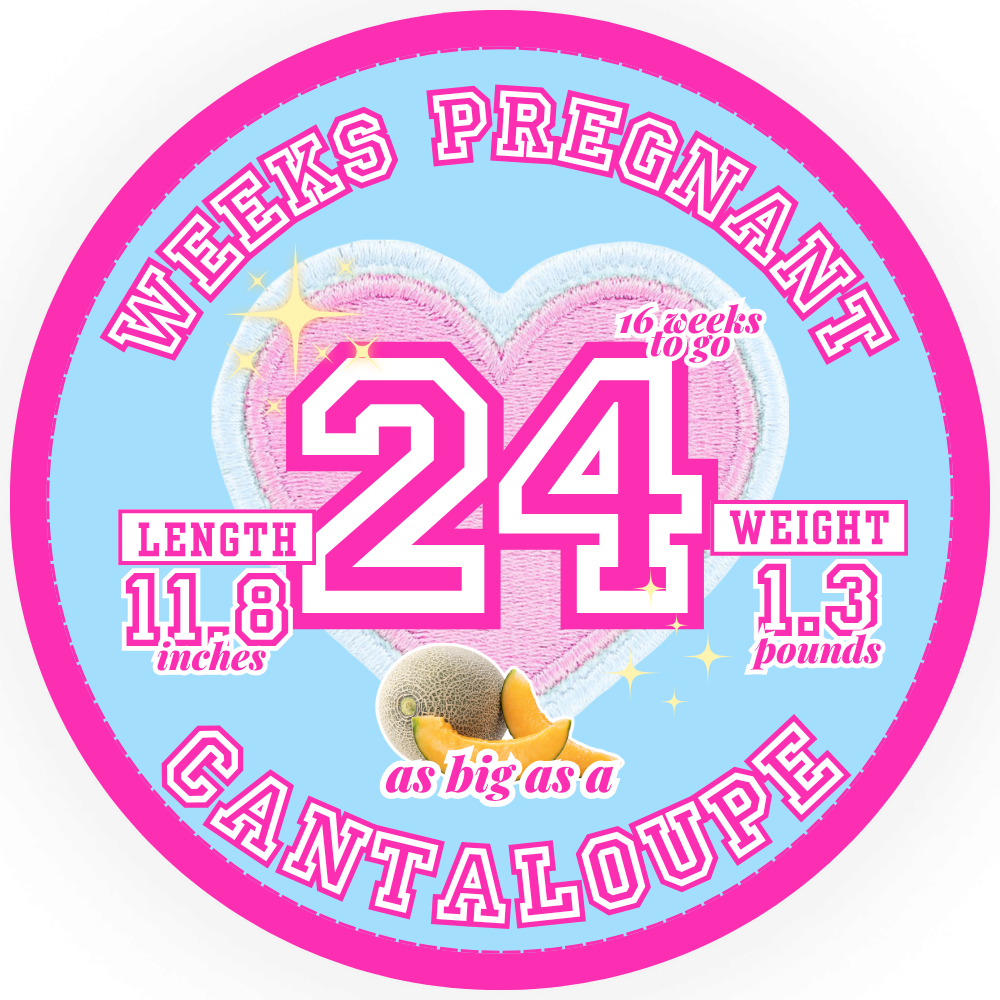
Baby’s growth and size
At 24 weeks your baby is somewhere between 11.5 and 11.8 inches long. Just slightly up from last week in weight, baby is right around 1.3 pounds.
What’s new developmentally?
Baby is still pretty tiny at 24 weeks but each and every day they are packing on the brown fat to help bulk up. In addition to their little body filling out, baby’s head hair, eyebrows and eyelashes are also continuing to fill out.
Baby’s skin still remains pretty thin and translucent, with a reddish hue, but not for too much longer. Your baby’s lungs are fully formed this week but still need more time before they could function normally outside of your womb.
Fun facts about your week 24 baby
- Baby’s hair lacks pigment so their eyebrows, eyelashes, and head hair are all white right now
- Baby’s inner ear is fully developed this week – this controls balance
- Baby’s startle reflex is now developed
How many months is 24 weeks pregnant?
At 24 weeks you are in your 6th month of pregnancy. Most commonly you will hear, “you are 20 weeks pregnant or I’m 25 weeks pregnant.”
It does get a little tricky when you start referring to pregnancy in months because it’s not an equal comparison. If this helps, you will be in your 6th month of pregnancy for weeks 23-27.
Position of baby at 24 weeks pregnant
It’s totally normal for your baby to not have settled into a head down position just yet. You might have heard to it referred to as vertex, cephalic, or head down, but most babies don’t settle into a head down position until week 30-32.
This doesn’t mean that you should panic if you are 34 weeks and your baby isn’t head down, they do still have time, but certainly don’t expect your little one to be head down at 24 weeks.
Baby being in what we call an “optimal position” for birth means they are not only head down but also facing down (occiput anterior or OA) can increase your chances of having a successful and uncomplicated vaginal birth. Again, this is not something you need to stress or lose sleep over at 24 weeks, just something to put on your radar for down the road.
24 weeks pregnant fatigue
Been feeling the pregnancy fatigue lately? You aren’t alone. Growing a baby is hard and exhausting work, mama! It may seem that no matter how much sleep you get, you just can’t kick the exhaustion.
There’s not much you can do about those middle of the night bathroom trips but there are some things you can do to help yourself get better quality sleep. Getting more sleep and better quality sleep is hard to come by in pregnancy; be sure to click here for some tips that can help!
It sounds counterintuitive, but consistent exercise can also help with pregnancy fatigue. It’s probably one of the last things on your mind, but some type of consistent exercise coupled with nutritious eating can make a big difference when it comes to fatigue.
Lastly, anemia can make you feel fatigued too. Anemia is actually pretty common in pregnancy and something your provider tests for throughout pregnancy.
For most anemic women, simply increasing the amount of iron in their diet and adding a daily over-the-counter iron supplement can make a big difference. If you are severely anemic, your doctor might recommend IV iron transfusions throughout pregnancy, but this isn’t super common.
24 weeks pregnant ultrasound
By 24 weeks, you should have already had your anatomy scan. It typically happens between 18 and 22 weeks. Some babies are less cooperative during the anatomy scan than others and like to play hide and seek, typically scoring themselves an additional ultrasound.
If the ultrasound tech was not able to visualize all of baby’s organs and body parts during the initial anatomy scan, then you probably have a follow-up ultrasound scheduled for them to look at whatever parts they were unable to see.
There are some other conditions that might warrant additional ultrasounds during pregnancy. Having a history of preterm birth, carrying multiples, concerns over baby’s growth, and certain medical conditions might lead to additional ultrasounds past the 20-week anatomy scan.

.png?width=1500&height=300&name=logo%201500x300%20(1).png)


